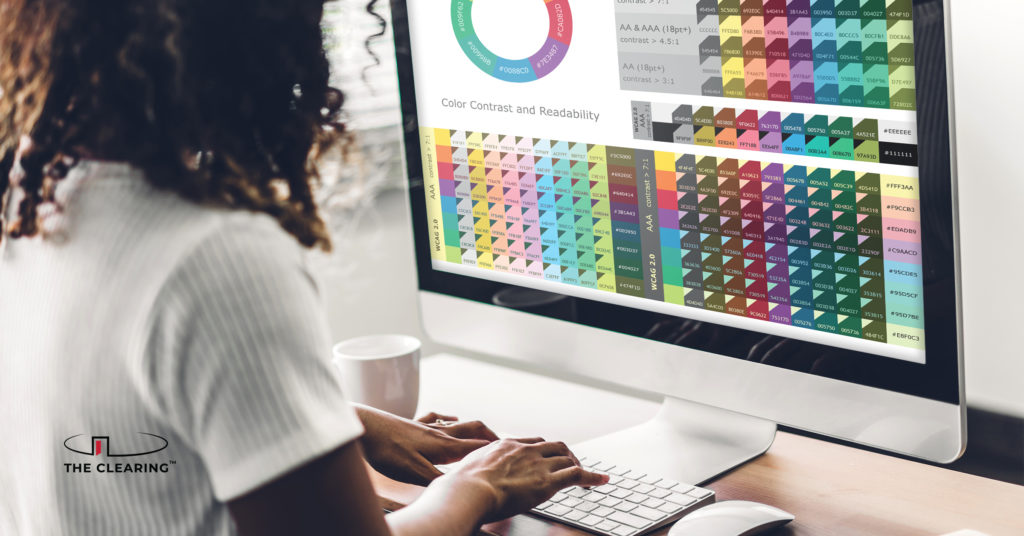Accessible Design
Accessible design is systems that are made from the perspective that they should function for everyone, regardless of any physical or mental limitations. It’s a principle that should be considered when designing almost anything – whether that’s physical infrastructure, digital experiences, or visual materials.
The Impact Accessible Visual Design Can Have on an Organization
In my professional opinion, accessible design has a LARGE impact on organizations. It has the same impact as when we think about diversity on any level. Organizations benefit from diverse perspectives because people experience the world in different ways. However, diversity inclusion must go beyond things we commonly think of, such as sexual orientation or socioeconomic and ethnic backgrounds, to include perspectives from those with physical or cognitive limitations.
In fact, 26% of U.S. adults live with some kind of disability.
This fact is critical for visual design. As visual designers, our job is to create materials that help organizations or brands effectively communicate, but we can’t do that if we’re leaving a large group of people who consume these materials out of the consideration set.
It sounds simplistic, but why would a company intentionally create a toaster that could only be used by 75% of the population? Not only is that ethically questionable, but it’s also a poor business decision. To bring it back to visual design, the same goes for the visual materials that accompany that toaster, including packaging, user guides, and more. So, designing for everyone isn’t only the right thing to do, it is also smart business for organizations of all types.
The Clearing’s Approach to Accessible Design
One of the things we have going for us is that most of our clients are somehow involved in the public sector. Due to federal regulations requiring equal access, many agencies are at the forefront of accessibility. And for some, that access is key to achieving their mission.
Here’s an example. We work with an agency that provides services to veterans. As we know, many veterans live with some sort of disability. When developing the visual design of everything from their website to communications materials, considering this audience was key to both operational effectiveness and customer experience. By evaluating needs based on the whole potential user group, we helped this agency ensure its services are useful to all the people who need them.
As we’ve written about before, customer experience is an increasing focus for government leaders. At The Clearing, we consider accessibility at every step of the consumer journey, including how we think about visual design. For example, our designers know that colorblindness isn’t a singular disability – there are actually multiple forms. Some people see blues and purples as the same, others see reds and yellows as the same. We embed this detailed approach into our work, ensuring that our clients can communicate effectively with 100% of their customers.

Example of a color contrast and readability graphics tool
The Risk for Leaders Who Don’t Incorporate Accessibility into Design
It’s pretty simple: if you fail to think with an inclusive mindset you risk leaving people behind and getting left behind yourself. As we talked about earlier, designing for only 75% of the population just isn’t a smart business decision. Secondarily, failing to take accessibility into account at the outset often results in retrofitting and rework down the road. That’s bad for your bottom line and for customer experience. It’s important for leaders to acknowledge that accessibility must be prioritized from the very beginning and that not considering those audiences may create an ineffective product at the end of the day.
How to Incorporate Accessible Design
- Include Accessibility from the Get-Go. As a leader, if you do one thing when it comes to accessibility it should be this. Retrofitting accessibility into an existing design or system can be a painful experience for both your budget and everyone involved: designers, developers, and – especially – users.
- Consider Diverse Perspectives. This goes hand-in-hand with our first point. When planning a project, solicit diverse perspectives. Because the best perspectives you can get are from the people that are coming from those perspectives, right?
- Rely on the Experts. Accessible design is a complex space. From knowing the best screen-reader programs to understanding color contrast to stay current on ADA guidelines, the ins and outs are tough to stay on top of. Combined with tips one and two, utilizing experts in the field of accessible design will help ensure you deliver a product or experience that is useful to 100% of your audience.
In closing, accessibility – and accessible design – is something we are passionate about here at The Clearing. If your organization is considering a new website, design system, or any type of customer-facing product experience, we can help ensure you plan for the needs of everyone in your target group – not just 75% of them. I’d love to chat with you about how we can help – I can be reached anytime at Daniela.aburto@theclearing.com.








 The Clearing’s Employee Experience
Improvement model, adapted from Itam
& Ghosh, 2020, focuses on three objectives:
The Clearing’s Employee Experience
Improvement model, adapted from Itam
& Ghosh, 2020, focuses on three objectives: 












